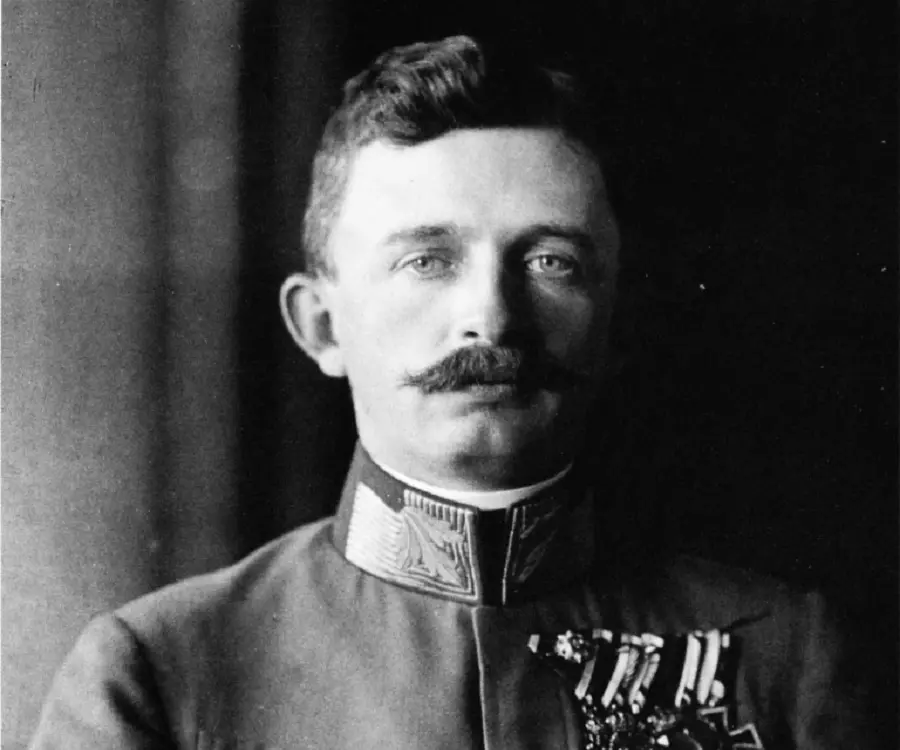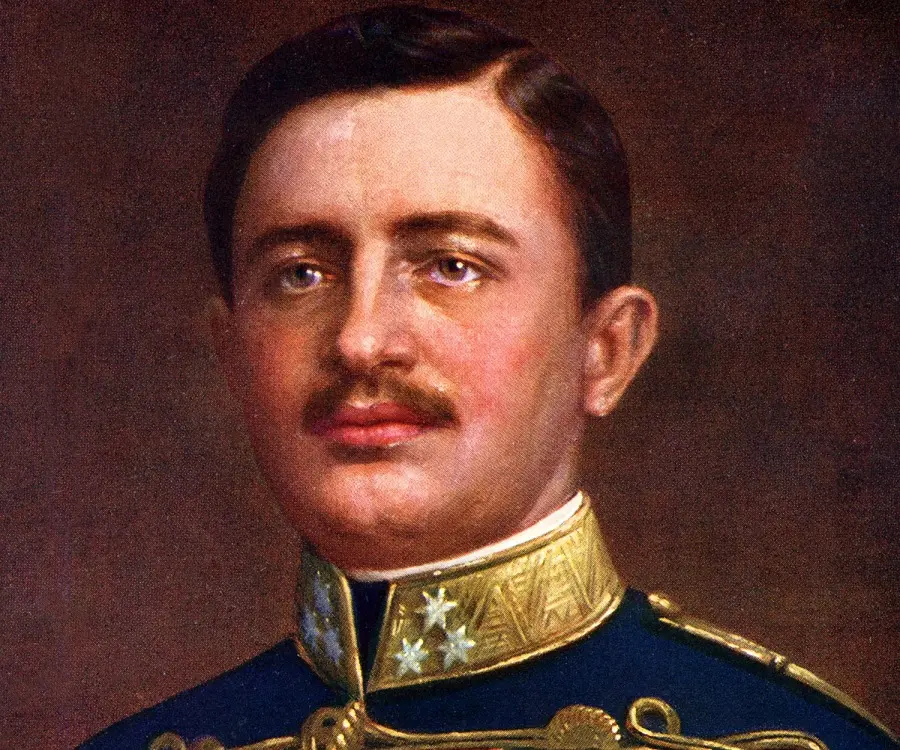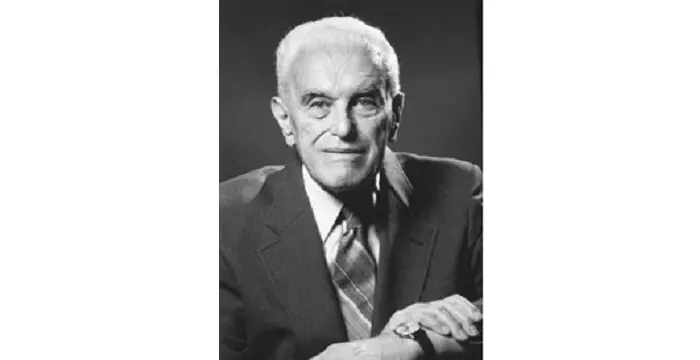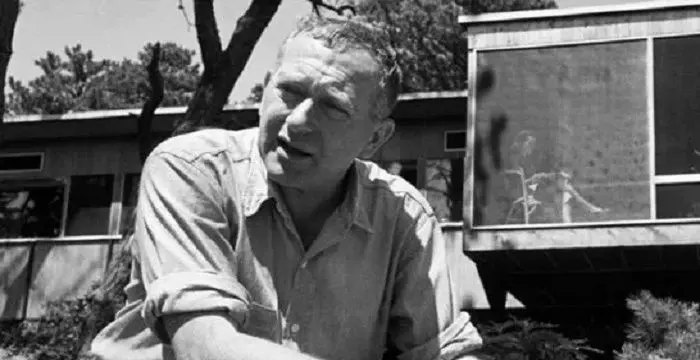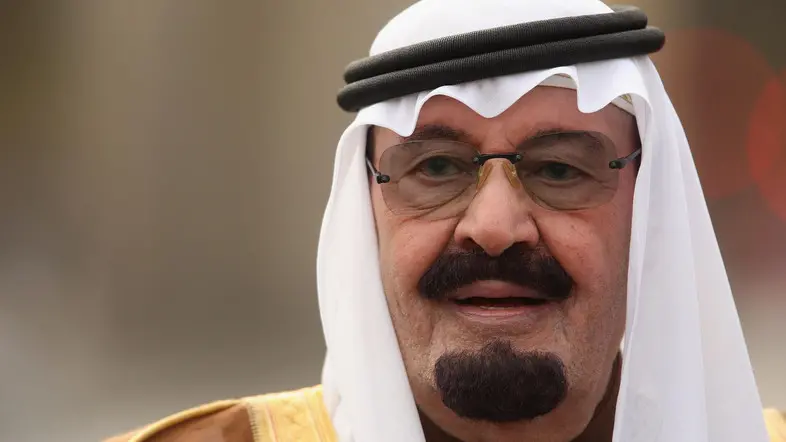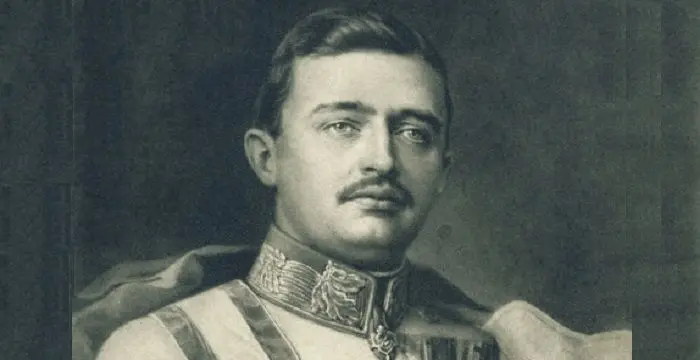
Charles I of Austria - Kings, Timeline and Childhood
Charles I of Austria's Personal Details
Charles I of Austria was the last Emperor of Austria and last King of Hungary
| Information | Detail |
|---|---|
| Birthday | August 17, 1887 |
| Died on | April 1, 1922 |
| Nationality | Hungarian |
| Famous | Historical Personalities, Emperors & Kings, Emperors, Hungarian Men, Kings, Last Ruler of Austro-hungarian Empire |
| Spouses | Zita of Bourbon-Parma |
| Siblings | Alfred Joseph von Hortenau, Archduke Maximilian Eugen of Austria, Hildegard von Hortenau |
| Known as | Charles I |
| Childrens | Archduchess Adelheid of Austria, Archduchess Charlotte of Austria, Archduchess Elisabeth of Austria, Archduke Carl Ludwig of Austria, Archduke Felix of Austria, Archduke of Austria-Este, Archduke Rudolf of Austria, Otto von Habsburg, Robert |
| Birth Place | Persenbeug-Gottsdorf |
| Religion | Catholicism |
| Gender | Male |
| Father | Archduke Otto of Austria |
| Mother | Princess Maria Josepha of Saxony |
| Sun Sign | Leo |
| Born in | Persenbeug-Gottsdorf |
| Famous as | Last ruler of Austro-Hungarian Empire |
| Died at Age | 34 |
// Famous Emperors
Sundiata Keita
Sundiata Keita was the founder of the Mali Empire in West Africa. This biography profiles his childhood, early life, struggles, founding of empire, rule, administration, achievements and also gives some fun facts.
Ashoka
Ashoka was the third emperor of the Mauryan Dynasty and ruled almost the entire Indian subcontinent. This biography profiles his childhood, life, reign, achievements and timeline
Murad IV
Murad IV was one of the mighty Sultans in the history of the Ottoman Empire. This biography profiles his childhood, family, accession, rule, administration and timeline.
Charles I of Austria's photo
Who is Charles I of Austria?
Popularly known as Blessed Charles of Austria, Charles I of Austria was the last ruler of the Austro-Hungarian Empire. He served as the last Emperor of Austria, the last King of Hungary and the last monarch of the House of Habsburg-Lorraine. Succeeding to the throne in 1914, same time as the outbreak of World War I, Charles made every possible effort to remove his country from war. However, his attempt backfired, as he lost public support for supporting French claims to the region of Alsace-Lorraine. It was under his reign that the multinational empire separated to form separate national unions. He spent the latter part of his life in exile, first in Switzerland and later in the Portuguese island of Madeira where he lived in poor conditions. He breathed his last on April 1, 1922 due to severe pneumonia.
// Famous Hungarian Men
John C Harsanyi
Read on to know the profile, career, important works, contributions and timeline of the famous American economist and Nobel Laureate, John C Harsanyi.
Erno Rubik
The famous inventor and educationist, Erno Rubik is known world-wide for his invention the ‘Rubik’s Cube’. To know more about the childhood, profile, timeline and career of this famous architect-inventor read on.
Marcel Breuer
Marcel Lajos Breuer was a world famous modernist architect and designer considered as one of the most prominent proponents of International Style. This biography profiles his childhood, life, career, achievements and timeline.
Childhood & Early Life
Charles I of Austria was born on August 17, 1887 in the Castle of Persenbeug to Archduke Otto Franz of Austria and Princess Maria Josepha of Saxony. He was the grandnephew of Franz Joseph, who then reigned as the Emperor of Austria and King of Hungary.
Raised as a devout Catholic, young Charles had a religious bent of mind. His catholic education made him turn to prayer before any important event or decision in life.
Charles spent his childhood years on the move, as he father’s regiment was continuously posted from one place to other. Later, he stuck to Vienna and Reichenau an der Rax.
Charles received much of his academic education privately. Later on, he attended a public gymnasium to study scientific subjects. After completing education, he entered army, serving as an officer in Prague from 1906 to 1908. Simultaneously, he studied law and political science.
In 1907, he had Prince Zdenko Lobkowitz as his chamberlain. In the subsequent years, he carried out military duties in Bohemian garrison towns. For much of his early years, Charles was detained from actively participating in the affairs of state due to cold relations with his uncle, Franz Ferdinand. He wasn’t given any political position either.
Accession & Reign
Following the assassination of his uncle Archduke Franz Ferdinand in 1914, Charles was automatically promoted as the heir presumptive to the Habsburg throne, as Ferdinand’s children were barred from succession due to his morganatic marriage.
Immediately after his appointment as the heir presumptive, a change in administration made him actively participate in the affairs of state. However, with the outbreak of World War I, his participation was merely symbolic as he exercised no military influence.
During the early years of World War I, he was appointed as the General Field Marshall in the Austria-Hungarian Army. He was later posted on the eastern front where he served as a commander of an army, operating against the Russians and Romanians.
Following the death of Emperor Franz Joseph in November 1916, Charles succeeded as the Emperor of Austria. On December 2, 1916, he took on the role of Supreme Commander of the army from Archduke Frederick. His coronation as the Emperor was held on December 30, 1916.
Immediately after taking up the throne, Charles secretly entered into peace negotiation with France. Although his foreign minister, Ottokar Czernin, was only interested in negotiating a general peace including Germany, Charles went much further and wilfully made a separate peace. However, his attempt did not bore result as he refused to cede any territory to Italy.
During much of the later years of the World War I, the Austria-Hungarian Empire was wrecked with inner turmoil as tension arose between the ethnic groups. The problems only aggravated in times to follow as ethnic groups demanded for separate nations and did not compromise with Charles proposal of self-governance under a common confederation.
On October 16, 1918, Charles issued a proclamation that virtually changed the nature of Austrian state. While Poles were granted full independence, rest of Austrian land was divided between German, Czech, South Slav, and Ukrainian. Trieste was awarded a special status.
Charles’ attempt to keep the multinational Austrian empire together lay stranded as within a frame of time, all the nationalities proclaimed their independence. Czechoslovakia allied with the Allies, while South Slav declared itself as an independent state. Furthermore, Hungary ended its personal union from Austria on October 31, 1918.
With the separation of provinces, Charles political future became uncertain. He had under his rule the provinces of Danubian and Alpine, which was also challenged by the German-Austrian State Council.
November 11, 1918 marked the end of war between Allied forces and Germany. Same day, Charles made a proclamation in which he renounced participation in the affairs of state. He also released his officials from the oath of loyalty. Two days later, he issued a similar proclamation for Hungary.
On November 12, 1918, independent Republic of German-Austria was proclaimed. Four days later, similar proclamation of Hungarian Democratic Republic followed.
In March 1919, Charles was exiled to Switzerland. Though he left yet another proclamation in which he confirmed his claim of sovereignty, the same wasn’t adhered to by the new Austrian parliament which passed the Habsburg Law on April 3, 1919 under which it completely barred Charles and his wife, Zita from entering Austria.
In 1921, Charles twice attempted to reclaim the Hungarian throne but failed miserably. Hungary's regent, Miklós Horthy refused to support him. To put an end to any attempt, the Hungarian parliament formally nullified the Pragmatic Sanction, as per which the Habsburgs were effectively dethroned.
Following his second failed attempt, Charles along with his wife was deposed to the Portuguese island of Madeira, thus ending all attempts for restoration. The family lived in impoverished conditions.
Personal Life & Legacy
Charles married Princess Zita of Bourbon-Parma, in 1911. The couple was blessed with eight children.
In March 1922, Charles suffered from a cold that worsened in the time to follow. From being just cold it developed into bronchitis and later took the form of severe pneumonia.
After suffering from two heart attacks, he breathed his last on April 1, 1922 due to respiratory failure. His body, except his heart, was interred on the island, in the Church of Our Lady of Monte. His heart, along with that of his wife’s, was later kept in the monastery of Muri, Switzerland.
Posthumously, Charles was appraised for his role as a peacemaker during World War I. He was beatified with the title ‘Venerable’ by Pope John Paul II on April, 2003 and later in October 3, 2004 was given the title of ‘Blessed’. His feast day is celebrated on October 21, the day of his marriage anniversary.
Charles I of Austria biography timelines
- // 17th Aug 1887Charles I of Austria was born on August 17, 1887 in the Castle of Persenbeug to Archduke Otto Franz of Austria and Princess Maria Josepha of Saxony. He was the grandnephew of Franz Joseph, who then reigned as the Emperor of Austria and King of Hungary.
- // 1906 To 1908Charles received much of his academic education privately. Later on, he attended a public gymnasium to study scientific subjects. After completing education, he entered army, serving as an officer in Prague from 1906 to 1908. Simultaneously, he studied law and political science.
- // 1907In 1907, he had Prince Zdenko Lobkowitz as his chamberlain. In the subsequent years, he carried out military duties in Bohemian garrison towns. For much of his early years, Charles was detained from actively participating in the affairs of state due to cold relations with his uncle, Franz Ferdinand. He wasn’t given any political position either.
- // 1911Charles married Princess Zita of Bourbon-Parma, in 1911. The couple was blessed with eight children.
- // 1914Following the assassination of his uncle Archduke Franz Ferdinand in 1914, Charles was automatically promoted as the heir presumptive to the Habsburg throne, as Ferdinand’s children were barred from succession due to his morganatic marriage.
- // 16th Oct 1918On October 16, 1918, Charles issued a proclamation that virtually changed the nature of Austrian state. While Poles were granted full independence, rest of Austrian land was divided between German, Czech, South Slav, and Ukrainian. Trieste was awarded a special status.
- // 31st Oct 1918Charles’ attempt to keep the multinational Austrian empire together lay stranded as within a frame of time, all the nationalities proclaimed their independence. Czechoslovakia allied with the Allies, while South Slav declared itself as an independent state. Furthermore, Hungary ended its personal union from Austria on October 31, 1918.
- // 11th Nov 1918November 11, 1918 marked the end of war between Allied forces and Germany. Same day, Charles made a proclamation in which he renounced participation in the affairs of state. He also released his officials from the oath of loyalty. Two days later, he issued a similar proclamation for Hungary.
- // 12th Nov 1918On November 12, 1918, independent Republic of German-Austria was proclaimed. Four days later, similar proclamation of Hungarian Democratic Republic followed.
- // 3rd Apr 1919In March 1919, Charles was exiled to Switzerland. Though he left yet another proclamation in which he confirmed his claim of sovereignty, the same wasn’t adhered to by the new Austrian parliament which passed the Habsburg Law on April 3, 1919 under which it completely barred Charles and his wife, Zita from entering Austria.
- // 1921In 1921, Charles twice attempted to reclaim the Hungarian throne but failed miserably. Hungary's regent, Miklós Horthy refused to support him. To put an end to any attempt, the Hungarian parliament formally nullified the Pragmatic Sanction, as per which the Habsburgs were effectively dethroned.
- // Mar 1922In March 1922, Charles suffered from a cold that worsened in the time to follow. From being just cold it developed into bronchitis and later took the form of severe pneumonia.
- // 1st Apr 1922After suffering from two heart attacks, he breathed his last on April 1, 1922 due to respiratory failure. His body, except his heart, was interred on the island, in the Church of Our Lady of Monte. His heart, along with that of his wife’s, was later kept in the monastery of Muri, Switzerland.
// Famous Kings
Sundiata Keita
Sundiata Keita was the founder of the Mali Empire in West Africa. This biography profiles his childhood, early life, struggles, founding of empire, rule, administration, achievements and also gives some fun facts.
Ashoka
Ashoka was the third emperor of the Mauryan Dynasty and ruled almost the entire Indian subcontinent. This biography profiles his childhood, life, reign, achievements and timeline
Murad IV
Murad IV was one of the mighty Sultans in the history of the Ottoman Empire. This biography profiles his childhood, family, accession, rule, administration and timeline.
Xerxes I
Xerxes I (Xerxes the Great) was the fourth and the most famous king of the Archaemenid dynasty of Persia. This biography profiles his childhood, family, personal life, life history, achievements, campaigns, administration, death and other facts.
Sargon of Akkad
Sargon of Akkad, also called ‘Sargon the Great’, ‘Sarru-Kan’ and ‘Shar-Gani-Sharri’, was the founder and first king of the Akkadian Empire. This biography profiles his childhood, life, rule, administration, timeline, and gives some fun facts.
Abdullah of Saudi Arabia
Abdullah bin Abdulaziz Al Saud was the King of Saudi Arabia from 2005 to 2015 and the third wealthiest head of state in the world. Find more facts about his life, childhood and timeline.
Charles I of Austria's FAQ
What is Charles I of Austria birthday?
Charles I of Austria was born at 1887-08-17
When was Charles I of Austria died?
Charles I of Austria was died at 1922-04-01
Where was Charles I of Austria died?
Charles I of Austria was died in Madeira
Which age was Charles I of Austria died?
Charles I of Austria was died at age 34
Where is Charles I of Austria's birth place?
Charles I of Austria was born in Persenbeug-Gottsdorf
What is Charles I of Austria nationalities?
Charles I of Austria's nationalities is Hungarian
Who is Charles I of Austria spouses?
Charles I of Austria's spouses is Zita of Bourbon-Parma
Who is Charles I of Austria siblings?
Charles I of Austria's siblings is Alfred Joseph von Hortenau, Archduke Maximilian Eugen of Austria, Hildegard von Hortenau
Who is Charles I of Austria childrens?
Charles I of Austria's childrens is Archduchess Adelheid of Austria, Archduchess Charlotte of Austria, Archduchess Elisabeth of Austria, Archduke Carl Ludwig of Austria, Archduke Felix of Austria, Archduke of Austria-Este, Archduke Rudolf of Austria, Otto von Habsburg, Robert
What is Charles I of Austria's religion?
Charles I of Austria's religion is Catholicism
Who is Charles I of Austria's father?
Charles I of Austria's father is Archduke Otto of Austria
Who is Charles I of Austria's mother?
Charles I of Austria's mother is Princess Maria Josepha of Saxony
What is Charles I of Austria's sun sign?
Charles I of Austria is Leo
How famous is Charles I of Austria?
Charles I of Austria is famouse as Last ruler of Austro-Hungarian Empire




